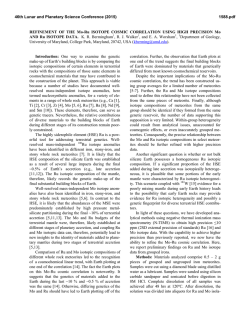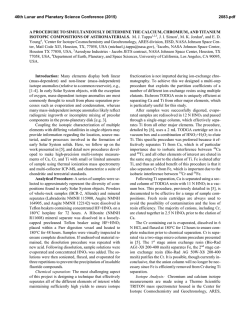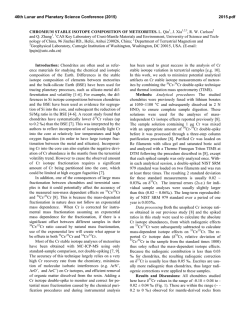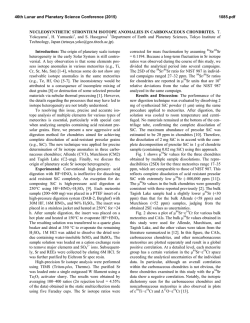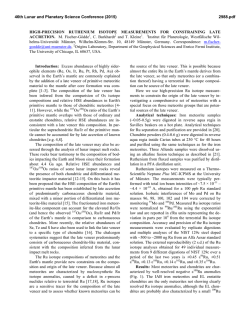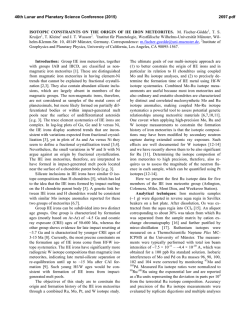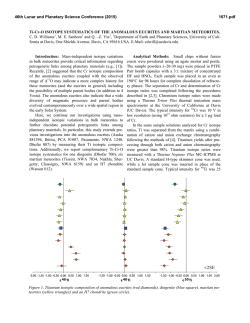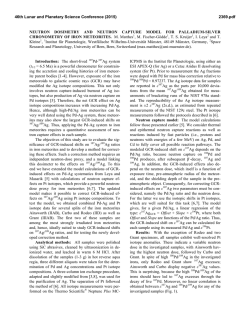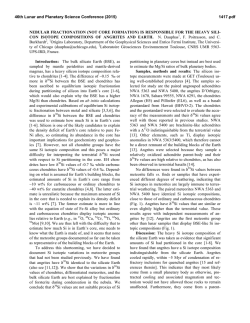
Tungsten Stable Isotope Variations Investigated Using a New
46th Lunar and Planetary Science Conference (2015) 2383.pdf TUNGSTEN STABLE ISOTOPE VARIATIONS INVESTIGATED USING A NEW DOUBLE SPIKE METHOD. N. Krabbe, T.S. Kruijer, G. Budde, and T. Kleine, Institut für Planetologie, Westfälische WilhelmsUniversität Münster, Wilhelm-Klemm Str. 10, 48149 Münster, Germany ([email protected]). Introduction: Mass-dependent isotope fractionation imparted by metal-silicate equilibration can be used to obtain constraints on the physical and chemical processes during core formation in the Earth, other terrestrial planets and asteroids [e.g., 1-3]. As the magnitude of stable isotope variations depends on the temperature of metal-silicate equilibration, stable isotope variability may help to constrain the conditions of terrestrial core formation. Tungsten is a refractory moderately siderophile element and of particular interest given its linkage to the short-lived Hf-W chronometer (t1/2 = 8.9 Myr) [e.g., 4], which is used to date core formation. However, the application of Hf-W chronometry to the Earth is severely hampered, because it is unclear how efficient the metal cores of accreting bodies re-equilibrated with the Earth's mantle before entering the core [5-7]. Tungsten stable isotope systematics of terrestrial and extraterrestrial materials may help to restrict this parameter by constraining the conditions of core formation in Earth directly. Several elements including Mo, Cr, and Si show stable isotope fractionations that were interpreted to result from core formation [1-3, 8], but it is unclear as to whether such variations extend to heavier elements like W. To utilize W stable isotope variations for investigating core formation requires a reconnaissance study of mass-dependent W isotope variations in meteorites and terrestrial samples. Tungsten stable isotope fractionations may not only occur during planetary differentiation, but also in the solar nebula, potentially leading to isotopic variations among different chondrites. For instance, mass-dependent isotope variations among chondrites have been observed for Mo [8]−like W a refractory siderophile element−and were interpreted to reflect the different nebular conditions under which carbonaceous chondrites formed compared to ordinary and enstatite chondrites. So far there is only a single systematic W stable isotope study, which investigated both terrestrial samples and meteorites [9]. This study reports relatively large W isotope variations with a total range of ~0.5 permil per amu. For comparison, a Mo isotope study on a similar set of samples found a much smaller range of mass-dependent isotope variations [8]. Thus, these results may suggest that W isotopes are a more sensitive tracer of the formation conditions of meteorites and terrestrial samples. However, W stable isotope data have so far only been obtained using the conventional standard-sample bracketing technique [9], which in most cases provides less precise results than the double-spike technique [10] (which has been used in the Mo isotope study [8]). As mass-dependent W isotope variations during high temperature processes are expected to be small, the double spike technique is the method of choice for determining variations in W stable isotope compositions to high precision. In this study we developed new analytical techniques for W stable isotope analyses using a double spike, with the aim to assess the magnitude of W isotope variations among meteorites and terrestrial samples. Here we present our first results obtained for the ordinary chondrite Kernouvé (H6), the carbonaceous chondrite Allende (CV3), the iron meteorite Henbury (IIIAB), and a terrestrial rock standard (AGV-2). Analytical methods: The 180W-183W double spike has been calibrated from two single spikes enriched in 180 W and 183W (obtained from Oak Rich National Laboratory, ORNL), which in turn were calibrated against the NIST SRM 3163 W standard solution. The optimal W double spike composition was calculated using the Double Spike Toolbox software [10]. The two single spikes (180W and 183W) were then mixed in the calculated optimal proportion (68.8 and 31.2 %). Prior to dissolution equal amounts of sample and doublespike were added to pre-cleaned Savillex® vials. The spiked samples were either dissolved in 2:1 mixtures of concentrated HF-HNO3 (silicate samples) or in HNO3-HCl (metal samples) on a hotplate for several days. Tungsten was separated from the sample matrix using a two-stage anion exchange chromotography in HCl-HF media based on previously developed procedures [11-13], which involves two columns filled with 4 ml and 1 ml anion exchange resin (BioRad® AG1X8, 200-400 mesh). In case of the silicate samples, the second column for the silicate samples also includes a step with H2O2 aimed at removing Ti, Zr, Ta and Hf from the sample matrix. Isotope measurements were performed using the ThermoScientific Neptune Plus MC-ICPMS in the Institut für Planetologie at the Westfälische WilhelmsUniversität Münster. Prior to measurement, the purified W cuts were redissolved in dilute HNO3-HF. The samples were introduced using an Aridus II desolvating system. Measurements were performed at total ion beam intensities of ~1.11-1.96×10-10 A, which was obtained for ~100 ppb W (uptake ~100 µl/min). Each measurement consisted of 90s baseline integrations (measured on-peak) followed by 100×4.2s of sample 46th Lunar and Planetary Science Conference (2015) 0.04 0.02 δ183/184W measurement. Ion beams at 180W, 182W, 183W, 184W and 186 W were simultaneously collected in a single cycle using Faraday cups connected to amplifiers with 1011 Ω feedback resistors. To monitor potential isobaric interferences at masses 180, 184 and 186, the ion beams at 178Hf and 188Os were also collected, using Faraday cups connected to amplifiers with 1012 Ω feedback resistors. The Os interferences were negligible for all of the investigated samples, but Hf interferences were significant for some samples. Nevertheless, tests with Hf-doped double spike-standard mixtures show that the Hf interference on mass 180 can be accurately corrected in solutions containing up to ~0.1 ppb Hf, corresponding to an interference correction of ~9 δ-units. For all the W stable isotope data reported here, Hf interference corrections were significantly smaller, however. Each sample measurement was bracketed by measurements of double spike-standard (NIST W SRM 3163) mixtures. The W isotope compositions of the samples are expressed in δ183W/184W as permil deviations from the NIST SRM 3163 W isotope standard. Data deconvolution for all analyses was performed with the Double Spike Toolbox [10] in MATLAB. Results and discussion: The reproducibility (2s.d.) of the δ183W/184W obtained for the spiked NIST 3163 W isotope standard during one measurement session is ±0.015 (Fig. 1). The true external uncertainty of samples is probably larger and still has to be assessed by repeated measurements of terrestrial rock standards. Nevertheless, the very good reproducibility of the spiked solution standard indicates that very precise W stable isotope data can be obtained using our double spike setup. Our measurement of AGV-2 reveals no resolvable W isotope fractionation from NIST 3163 (δ183W/184W ≈ 0.02) and so we do not reproduce the large fractionation of δ183W/184W = –0.36±0.01 reported in an earlier study [9]. For Kernouvé and Henbury the measured δ183W/184W values are also not resolved from zero, which again seems inconsistent with fractionations of >0.1 permil reported for an ordinary chondrite and the IVA iron Gibeon in previous work [9]. For Allende we obtained a slightly negative δ183W/184W value, but whether this is resolved from NIST 3163 needs to be assessed by further analyses. Again our data do not seem consistent with the large fractionation of δ183W/184W = –0.32±0.03 reported previously [9]. Thus, compared to the earlier study [9], our initial results show a much smaller magnitude of W isotope fractionation in meteorites. The reason for this discrepancy is unclear at present and needs further investigation by obtaining new W stable isotope data for additional meteorites and terrestrial samples. If the smaller 2383.pdf 0 -0.02 δmean = -0.001 ± 0.015 (2 s.d., n=9) -0.04 Fig. 1: Results obtained for the spiked W isotope standard (NIST 3163) during one measurement session. The mean value (blue line) and associated uncertainty (2s.d., shaded area) are also shown. Error bars represent internal uncertainties (2s.e.). range of δ183W/184W values indicated by our initial results is confirmed by new analyses, then the magnitude of mass-dependent W isotope fractionations among meteorites may be small, similar to that observed for Mo isotopes [8]. Although this would render W stable isotopes less applicable for investigating processes in the solar nebula, it would make this system a useful tool for investigation of planetary core formation, because the bulk composition of asteroids and terrestrial planets could be precisely defined through the analyses of chondrites and iron meteorites. Acknowledgements: Funding from the European Research Council under ERC Consolidator Grant agreement 616564-ISOCORE is gratefully acknowledged. References: [1] Georg, R.B. et al. (2007) Nature, 447, 1102-1106. [2] Hin, R.C. et al. (2013) EPSL, 379, 38-48. [3] Moynier, F. et al. (2011) Science, 331, 1417-1420. [4] Kleine, T. et al. (2009) GCA, 73, 51505188. [5] Halliday, A.N. (2004) Nature, 427, 505-509. [6] Kleine, T. et al. (2004) EPSL, 228, 109-123. [7] Rudge, J.F. et al. (2010) Nature Geosci., 3, 439-443. [8] Burkhardt, C. et al. (2014) EPSL, 391, 201-211. [9] Breton, T. and G. Quitte (2014) JAAS, 29, 2284-2293. [10] Rudge, J.F. et al. (2009) Chem. Geol., 265, 420431. [11] Kleine, T. et al. (2012) GCA, 84, 186-203. [12] Kruijer, T.S. et al. (2013) EPSL, 361, 162-172. [13] Kruijer, T.S. et al. (2014) EPSL, 403, 317-327.
© Copyright 2025
